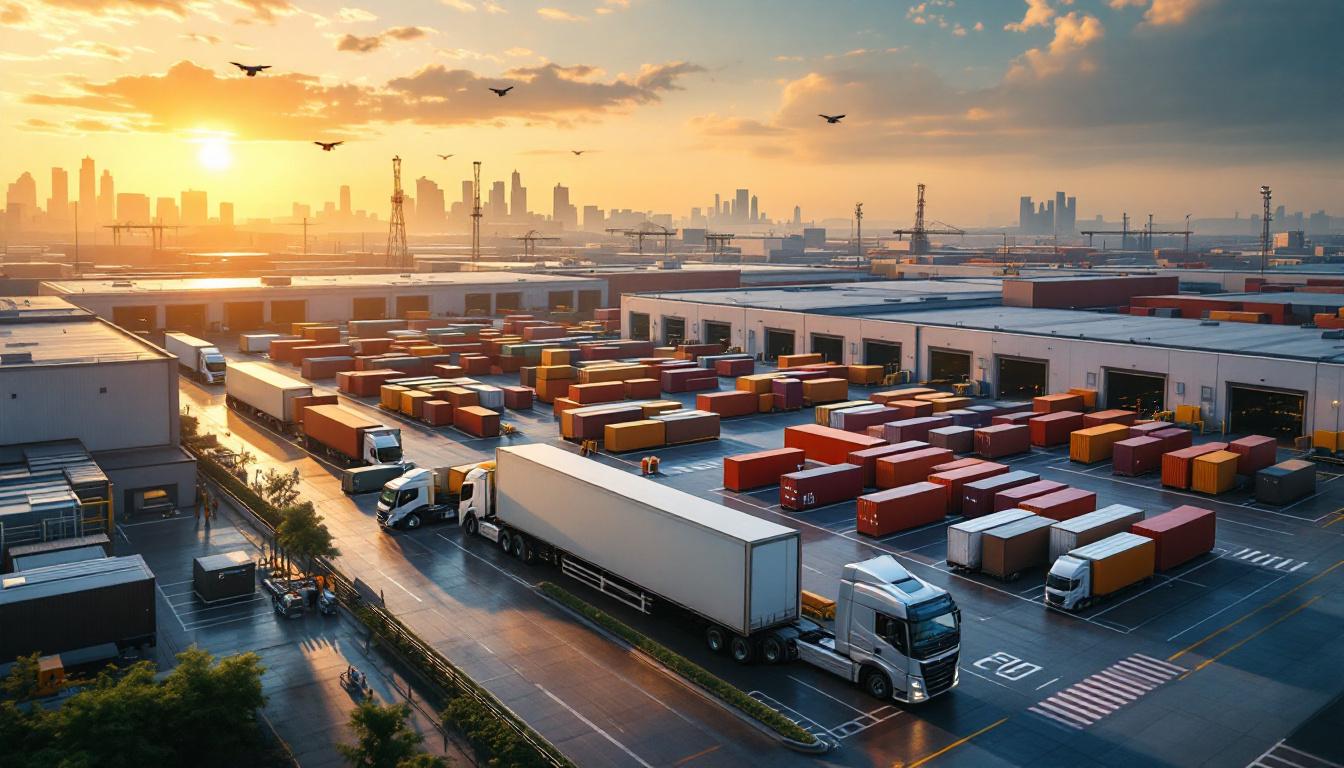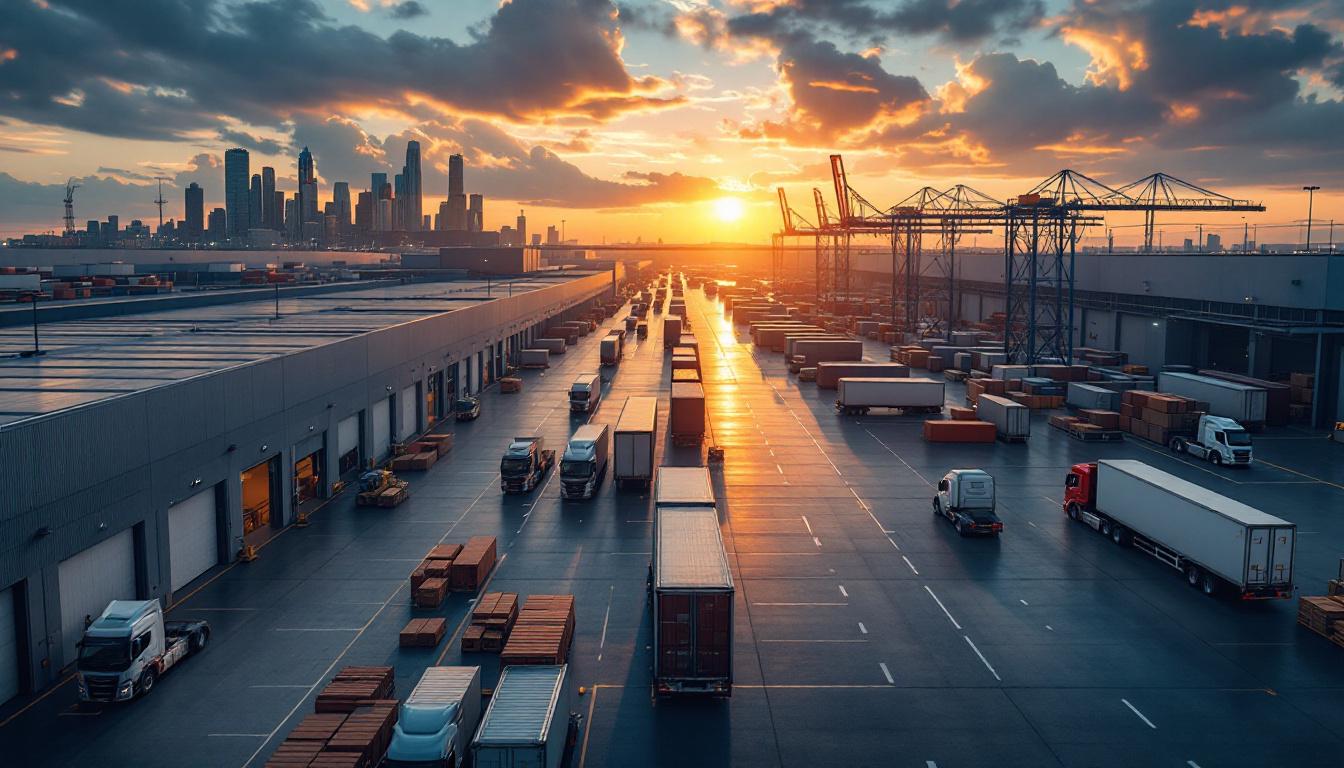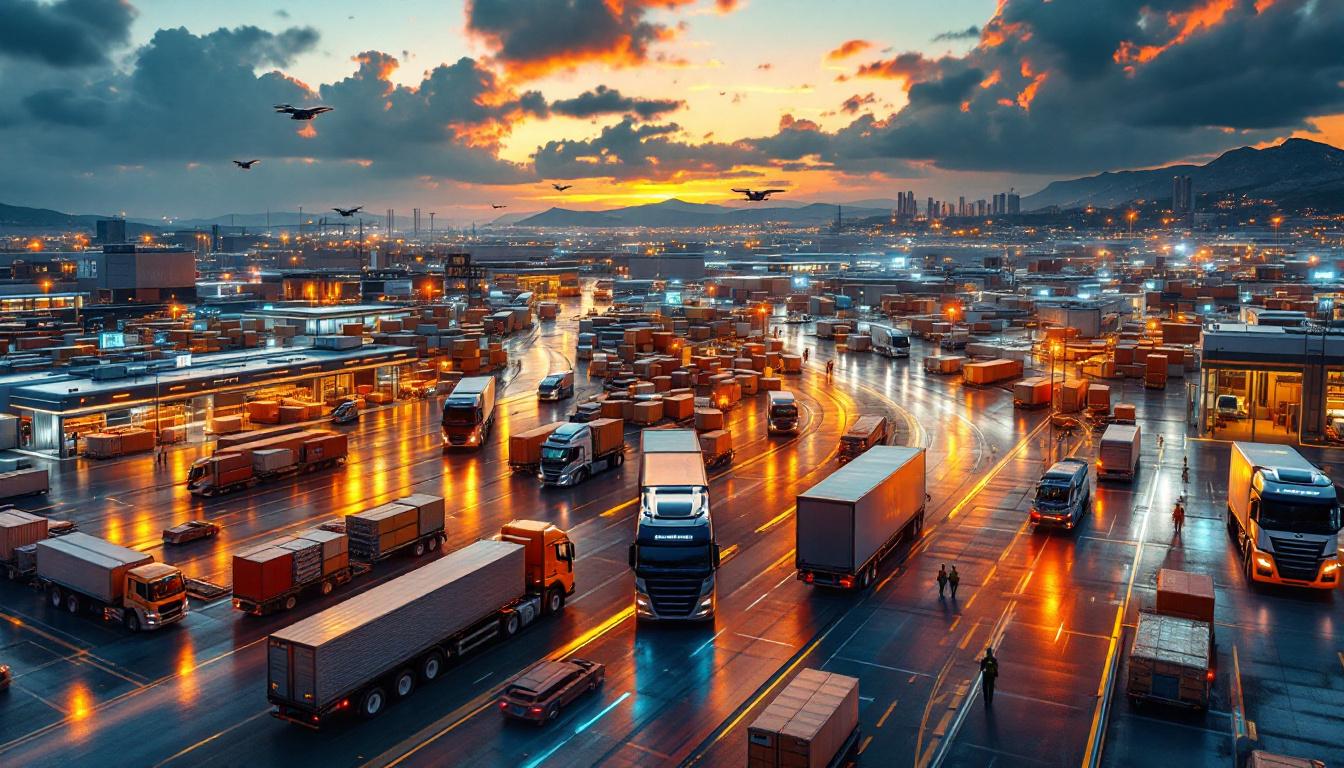![How 3PL Location Impacts Your Business: Shipping Costs, Customer Satisfaction, and Growth [Updated 2025]](https://msl-indy.com/wp-content/uploads/2025/08/modern-3pl-warehouse-shipping-port-sunrise.jpg)
How 3PL Location Impacts Your Business: Shipping Costs, Customer Satisfaction, and Growth [Updated 2025]
Where your 3PL location sits can make or break your business outcomes. With shoppers wanting fast delivery and low costs, a well-placed 3PL warehouse has a direct effect on shipping expenses, efficiency, and your customers’ happiness. Companies that choose smart 3PL locations often see lower transportation costs, quicker delivery speeds, and smoother supply chain operations. In a market where every mile and minute counts, the right 3PL location is no longer optional, it’s essential for keeping your business running smoothly, scaling quickly, and pleasing customers. To learn more about the different types of providers and how to sort through your options, you can check out this updated list of 3PL company types in the US for 2025.
Why 3PL Location Matters in Logistics Strategy
The location of your 3PL partner is much more than a pin on the map. It shapes everything from your daily delivery times to the long-term growth of your brand. Every mile between your warehouse and your customer eats into speed, cost, and satisfaction. With so much riding on warehouse location, understanding how to weigh these choices can give your business a real edge.
The Fundamentals of 3PL Location
A 3PL location is the physical site where your third-party logistics provider operates and stores your goods. It might seem simple: pick a convenient spot, ship your products, done. In reality, the location of your warehouse weaves into every supply chain link. The right placement can shave days off delivery, cut shipping costs, and keep your supply chain nimble. On the flip side, the wrong choice can slow your operations and drain your profit margins.
If you want a complete walk-through of how to pick a location that works for your needs, check out this guide to How to find a 3PL warehouse in the USA.
Proximity to Transportation Hubs
Transportation hubs are the arteries of logistics. These include major highways, rail lines, ports, and airports—core points where products swap from one mode of transit to another. Warehouses near these hubs are naturally set up for fast, reliable shipping. They allow companies to reach more customers with less travel and at better rates.
A well-placed 3PL location:
- Reduces transit distances to key trucking, rail, or air providers.
- Lowers shipping costs due to fewer miles and less complexity.
- Enables faster turnarounds for high-volume or urgent orders.
- Shrinks risk of late deliveries by minimizing handoffs and bottlenecks.
If your 3PL is close to a major transportation network, you’re not just marking off a logistics box—you’re setting up for lasting savings and better delivery performance. Learn more about how proximity can drive both speed and cost savings in this focused guide to Choosing warehouse locations.
Serving Customers and Suppliers Faster
The location of a 3PL doesn’t just matter to your business, it matters to your customers too. Placing your inventory closer to where your top buyers live means you can promise shorter shipping windows and faster delivery. This is especially important for e-commerce, where speed is now expected even for low-cost orders.
The same goes for suppliers. A central 3PL site makes it easier to keep shelves stocked and avoid long lead times. With a strong geographic footprint, you can move quickly when demand spikes or supply chains hit turbulence.
Key benefits of being close to customers and suppliers:
- Quick order fulfillment leads to better reviews and fewer complaints.
- Improved inventory turns and lower stockout risks.
- Less risk of spoilage or delays for perishable and urgent goods.
Agility, Resilience and Geographic Coverage
A single, distant warehouse puts your supply chain at risk. One storm or traffic jam near your only distribution center could spell widespread delays. Businesses looking for agility often use multi-node strategies—placing inventory in several locations to create a network of flexible options.
A thoughtful 3PL location strategy supports:
- Agility: Quickly reroute or shift resources as customer needs change.
- Resilience: Bounce back from interruptions like weather, strikes, or accidents.
- Geographic coverage: Reach more of your market with consistent, reliable shipping.
Adopting multi-node distribution centers is a proven way to stay competitive and minimize risk. If you want deeper insight into strategies that increase reliability, read up on Risk Management in Supply Chains.
Building a Winning 3PL Location Strategy
Building your strategy starts with more than a map. It’s about mapping your buyer hot spots, forecasting growth, and matching warehouse options to real-world demand. Whether you sell nationwide or focus on a single metro area, getting location right means your products can move with purpose, not just luck.
If you’re ready to take your logistics to the next level, compare your options and learn from the best 3PL providers in Indianapolis, a logistics hub that sets the standard for smart warehouse placement.
Core Business Impacts of 3PL Location
The true value of 3PL location shows up in daily operations, shaping how your business controls costs and keeps pace with demand. It’s more than geography. The right site can cut shipping expenses, trim delivery times, and give your company the flexibility to grow fast or ride out unexpected bumps. Whether you’re running a tight operation or scaling up, 3PL location plays an active part in cost savings and customer service.
Shipping Costs and Transit Times
The gap between your warehouse and your customers sets the tone for your shipping budget and how quickly packages arrive. When your 3PL location sits near major highways, airports, or ports, you see serious perks. Transportation routes act as supply chain shortcuts, turning a complex drive into a quick trip across town.
How location affects your shipping costs and speed:
- Shorter routes equal lower fuel spend and fewer labor hours. This is true for both parcel and freight services.
- Proximity to major carriers (think UPS, FedEx, regional trucking) often translates to more frequent pickups and lower service fees.
- Easy access to ports or transport hubs can slash costs for importers and exporters. You pay less for drayage and see faster container turnarounds.
A business shipping mostly to the Midwest might see their per-package cost drop by 15-25 percent if their 3PL is centrally located versus shipping cross-country. For a growing e-commerce brand, this adds up to thousands in annual savings and helps lock in fast, reliable delivery.
If you’re selling locally in dense metro areas, the right warehouse can even make next-day and same-day delivery possible—opening doors to services that keep shoppers happy. To dig deeper into tactics for finding an optimal warehouse, check out these top warehouse selection tips in Indianapolis.
Inventory Management and Scalability
A good 3PL location also supports smarter inventory management. By having stock closer to your core customers, you avoid over-ordering just to cover slow transit times. This means lower carrying costs, less risk of overstocking, and more cash to put into marketing or product development.
Direct ways 3PL location helps manage inventory and scale:
- Balanced stock levels: Ship inventory in smaller, smarter batches and respond to shifting sales patterns without huge surplus sitting on the shelves.
- Streamlined demand forecasting: Real-time order data lets you restock more precisely, with product movement that matches local demand.
- Room to scale: When growth is quick—during seasonal jumps or after a big marketing win—a 3PL that’s well-placed can flex operations. No need to scramble for extra space or workforce since you’re already close to trucking centers and a strong labor market.
For small retailers, this might mean cutting “dead stock” storage by 20 percent and improving cash flow right away. Larger brands benefit by avoiding nationwide out-of-stock pain during sudden spikes.
If your business needs to prepare for busy seasons or unpredictable spikes, having inventory at a strategic site gives you a solid footing. To learn more about using location strategy for resilience, read up on Managing Supply Chain Risks with 3PL for tips on staying ahead of disruptions.
Thoughtful 3PL placement lays a foundation for long-term growth and steady operations, whether you’re shipping hundreds or thousands of orders per week.
Operational Flexibility and Customer Experience
A well-placed 3PL location can make the difference between an average experience and a memorable one for your customers. Operational flexibility is the secret ingredient that lets you respond when markets shift or customer expectations jump overnight. When your warehouse is in the right spot, you open up new ways to meet fast-shipping demands, handle surprises, and keep your business moving forward. Whether you sell to one region or across the country, a 3PL with smart geographic placement brings real advantages for both your operation and your buyers.
Meeting Consumer Expectations for Delivery
Customers want their orders fast—often same-day or within two days. This shift has raised the bar for every brand. If your 3PL location is close to your main customer base, you’re set up to deliver on these expectations, even for last-minute shoppers or urgent shipments.
Strategic positioning of your 3PL helps you:
- Promise and deliver rapid shipping windows to a broader region.
- Offer weekend or next-morning delivery options without high costs.
- Stay competitive against bigger retailers who have already set the pace.
Think of distribution like a relay race: the closer your starting runner (your warehouse) is to the finish line, the quicker your team crosses it. To serve expanding markets, a 3PL with good reach lets you skip unnecessary miles, reduce transit times, and shrink delivery windows, turning your logistics into a true selling point.
Indianapolis is a good example of why location matters. With its central position and strong transportation network, top 3PL providers in Indianapolis can help businesses access over half the U.S. population within a day’s drive. This reach supports fast shipping at lower costs, giving brands a real edge in customer satisfaction. For a closer look at how regional distribution can improve delivery, visit this guide on the advantages of warehousing and distribution in Indianapolis.
Mitigating Risks and Supply Chain Disruptions
Unexpected problems can hit your supply chain at any time. Congestion, labor strikes, severe weather, and even regional events can disrupt normal flow. An optimized 3PL location helps you sidestep these headaches and keep your promises to customers.
By placing your warehouse in the right region, you can:
- Avoid known congestion points and weather trouble zones.
- Reroute orders quickly if a disruption happens in one area.
- Shorten the supply chain and reduce the number of “handoffs,” which lowers risks tied to errors or delays.
Picture optimal warehouse placement like a well-designed traffic system: when one road is blocked, there’s always another clear route. Running your operation with this kind of flexibility limits your exposure to breakdowns and bottlenecks, helping you serve customers even during unexpected events.
Businesses working with adaptable 3PL providers can also tap into smart practices that keep things running smoothly. For example, by maintaining regional inventory buffers and using technology that predicts disruption, you can reduce downtime and avoid costly order cancellations. Learn more about how supply chains work and why risk management starts with location in this guide on Understanding Supply Chain Operations.
When you combine the right 3PL location with the ability to adapt, your business runs with more confidence, no matter what comes your way. Strategic warehouse positioning supports fast delivery, happy customers, and steady business growth, even during uncertain times.
Cost Control, Sustainability, and Brand Image
A smart 3PL location strategy does more than streamline logistics—it directly shapes your business’s bottom line, carbon footprint, and how customers see your brand. As supply chains modernize, businesses now face expectations well beyond just being efficient. Costs, sustainability, and reputation are all tightly connected to where your third-party logistics partner operates.
Balancing Real Estate Costs and Labor Access
Picking the right warehouse location often means threading the needle between affordable real estate and a strong local workforce. In crowded metro markets, facility costs are sky-high and competition for workers is fierce. Shifting to less congested, cost-effective areas can unlock several wins.
- Lower Operational Costs: Warehouses in outlying regions or secondary markets usually have cheaper rent, utilities, and property taxes. These savings add up quickly, especially for brands with slim margins.
- Available Labor Pool: Locations near smaller towns can provide a steady supply of workers, often at a lower wage rate and with less turnover than city centers.
- Reduced Congestion: Operating away from urban bottlenecks means fewer shipping delays and smoother daily operations.
Choosing a strategic 3PL location translates into real, repeatable cost control. Firms that rethink location often enjoy better profit margins, without compromising service. To find more ways to trim overhead and drive performance in your supply chain, check out these Lean Logistics Strategies for Supply Chain Optimization.
Behind the numbers, there’s also a growing pressure for smarter, greener facilities. Affordable sites often come with the chance to invest in energy-saving upgrades—think LED lights or solar panels—that might be out of reach in big-city properties.
Sustainable Logistics Practices and Market Advantage
Consumer trends show that sustainability isn’t just a buzzword—it’s a deciding factor in purchase decisions and brand loyalty. An optimized 3PL location goes hand in hand with greener logistics, making it easier for your business to walk the talk.
When your 3PL sits close to your customer base or major suppliers, you cut shipping miles, fuel use, and greenhouse gas emissions. Shorter trips also mean you can use more regional carriers or eco-friendly delivery options. Here’s what this shift looks like in practice:
- Lower Emissions: Reducing delivery distances has a direct impact on carbon footprint. Fewer miles per order is the fastest way to shrink your environmental impact.
- Efficient Transportation: Modern 3PLs often use advanced routing software and consolidated loads to cut waste, which works best when warehouses are near key markets.
- Brand Reputation: Many shoppers check a company’s eco-credentials before buying. Demanding sustainable logistics shows you “practice what you preach” and builds trust.
Brands across the country now choose 3PL providers who invest in energy-efficient buildings, EV fleets, and green packaging. This shift is clear in the new Updated list of 3PL company types in the US for 2025, where sustainable, tech-driven options are rising fast.
It’s not just good PR—these choices often boost cost savings too. For example, packaging that uses recycled materials or right-sized boxes lowers both environmental impact and shipping fees. If you want to see how creative, industry-tailored solutions can further this advantage, visit these tips on Customized 3PL Services Tailored to Your Industry.
Sustainable logistics also help sidestep common problems like regulatory penalties or local opposition to high-pollution sites. Developing smart, eco-friendly distribution supports smooth operations while showing customers you care—giving your brand one more reason to stand out.
Industry Trends: The Future of 3PL Location Strategy
3PL location strategy is undergoing rapid change as new technologies and distribution models reshape logistics. The next five years will feature big shifts, from multi-node networks to smarter, automated warehouses. Understanding these trends can help you position your business for lower costs, faster shipping, and stronger supply chain performance.
Rise of Multi-Node Distribution Networks
Many companies are moving away from single, central warehouses to networks of multiple facilities. This “multi-node” approach helps brands:
- Store inventory close to key customer clusters
- Shorten shipping distances and lower costs
- Offer same-day or next-day delivery to more regions
Multi-node networks also make operations nimble. When demand shifts or supply chains hit a snag, inventory can be redirected quickly. E-commerce has pushed this trend, but even traditional retailers are following, breaking up their supply chains to serve shoppers better.
In the next five years, expect more brands—regardless of size—to use analytical tools to design custom delivery networks. Companies will choose 3PL locations not just for cost, but for reach and performance.
Warehouse Automation and Robotics
Warehouse automation is no longer just for big companies. Automated solutions, from conveyor belts to advanced robotics and wearable tech, are now common in 3PL locations.
These changes bring several benefits:
- Faster, more accurate order picking: Robots and automated guides slash errors and speed up delivery.
- Lower labor costs: Automation reduces the need for seasonal or overtime staff.
- Scalability: Sites can handle growth without major new hires or training.
Automated warehouses allow third-party logistics providers to process both small orders and bulk shipments with equal ease. The payoff? Consistent speed and reliability, even during peak demand.
To uncover more about the role of automation in logistics efficiency, you may want to read about how to enhance 3PL efficiency.
Tech-Enabled Distribution and Smart Analytics
The smartest 3PL locations use technology to drive every decision. Cloud-based platforms, real-time inventory management, and predictive shipping analytics aren’t just buzzwords—they’re the new baseline for modern warehouse operations.
3PLs now apply:
- IoT sensors for real-time product tracking
- AI and machine learning for demand forecasting, routings, and staffing
- Digital dashboards for instant visibility into inventory and shipments
These tools help companies make quick, data-driven choices on where to store goods, restock, or reroute inventory in response to outside pressures.
Sustainability and Urban Fulfillment
Sustainability is becoming a top factor in 3PL location choice. Customers want lower-carbon shipping and brands need to show commitment to responsible logistics. The push for eco-friendly warehouses, electric fleets, and shorter last-mile delivery routes has changed the map—sometimes literally.
Micro-fulfillment centers are popping up closer to major urban areas. By reducing delivery distances, these sites shrink the carbon footprint and help companies stay competitive when shoppers want rapid delivery.
Sustainable strategies also include:
- Energy-efficient lighting and solar-powered warehouses
- Optimized route planning to minimize fuel use
- Green packaging and circular supply chain practices
For companies looking to trim both emissions and expenses, these trends make certain locations more attractive.
Adapting to a Dynamic Market
3PLs and their customers face constant changes—new regulations, shifting consumer demands, and global events. The best strategy is flexibility, which often means combining the trends above for a custom fit.
To stay competitive, businesses are:
- Partnering with 3PLs who offer modular, tech-forward solutions
- Outsourcing warehousing to providers with strong regional footprints and adaptive strategies (see the full list of benefits to outsource warehousing to 3PL)
- Training staff in new technology and customer service skills
Overall, the future of 3PL location strategy is driven by smarter, faster, and greener operations. Companies that follow these trends will unlock new ways to control costs, speed up shipping, and strengthen customer satisfaction.
Conclusion
Decisions around 3PL location create real results. Businesses that put warehouse placement at the center of their supply chain planning see faster shipping, lower costs, happier customers, and a positive reputation in the market. With today’s demand for both speed and sustainability, treating 3PL location as a top priority is a smart, future-ready move.
Now is the time to review your current logistics setup and see if your 3PL network truly supports your business goals. Assess your distribution footprint and look for ways to improve efficiency, coverage, and customer service by rethinking location choices. For a deeper look at the operational basics that shape your 3PL decisions, check out Understanding the Basics of 3PL Logistics.
Thank you for reading—reaching the next level in logistics begins with strong, informed choices. How could a smarter 3PL location strategy drive results in your business? Share your experience or connect for more ideas on building a supply chain that supports lasting growth.






